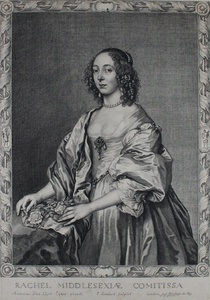| Method | Copper engraved |
| Artist | Pierre Lombart after Anthony van Dyck |
| Published | Londini, auec Priuileige du Roy et ex. parsisis [c. 1662] |
| Dimensions | Image 345 x 240 mm |
| Notes |
A quarter length portrait of Rachael, Countess of Bath and later Middlesex, standing and turned left, gazing at the viewer. She is wearing a voluminous silk dress, decorated with pearls, and wearing pearls around her neck as well as in her hair. She is holding unto the seem of her shawl, which has some freshly picked roses on it. The portrait is based on a painting by van Dyck's, and was included in Pierre Lombart's most famous work, often called The Countesses. The series contained twelve portraits after Anthony van Dyck, each of which depicted the sitter in three-quarter length. The ten women and two men illustrated in the series were; Anne Carr, Countess of Bedford; Lucy, Countess of Carlisle; Margaret, Countess of Carlisle; Anna Sophia, Countess of Carnarvo; Elizabeth, Countess of Castlehaven; Elizabeth, Countess of Devonshire; Rachel, Countess of Middlesex; Penelope, Lady Herbert; Dorothy Sidney; Countess of Sunderland; Elizabeth, Countess of Morton; Henry Howard, Earl of Arundel; and Philip Herbert, Earl of Pembroke. Rachael (née Fane) Bourchier, Countess of Bath and later Cranfield, Countess of Middlesex (1613-1680) was the daughter of Francis Fane, the 1st Earl of Westmoreland. As a young woman, she wrote plays, known as "masques" performed at family entertainments, and she would remain writing throughout her life. She married Henry Bourchier, the 5th Earl of Bath in 1638, who was active in the Royalist cause, as were her brothers Midmay and George. After the earl died in 1654, Rachael married Lionel Cranfield, the 3rd Earl of Middlesex, who was much younger, and a Bedchamber to King Charles II, but it was not a successful marriage. Anthony van Dyck (1599-1641) was one of the most prominent Flemish Baroque painters. Born in Antwerp, he was a pupil of Hendrik van Balen, but was soon noticed by Rubens with whom he would work closely during his early career. Van Dyck became a master of the St Luke Guild in 1618, went on to paint in Italy from 1621-1626, and then worked predominantly in England from 1632 onwards, where he was knighted by Charles I. Van Dyck was very prolific, he produced many portraits for members of the European aristocracy, as well as religious and mythological paintings and works on paper. Pierre Lombart (c. 1612 - 1681) was a French born engraver, working in both France and England. Although being a well recognised engraver in England, relatively little is known about his life. The first trace of Lombart in England is around 1649, and he went on to engrave numerous plates for Ogilby's various publications. Lombart's time in London can roughly be traced through his plates, which were usually inscribed with 'a Londres', and are dated until 1660. By 1663, he had returned to Paris, where he remained for the rest of his life. O'Donoghue 1; New Hollstein (Dutch & Flemish) 258. ii (Van Dyck) Condition: Trimmed within plate mark, without loss and laid to album page. |
| Framing | unmounted |
| Price | £150.00 |
| Stock ID | 46894 |

